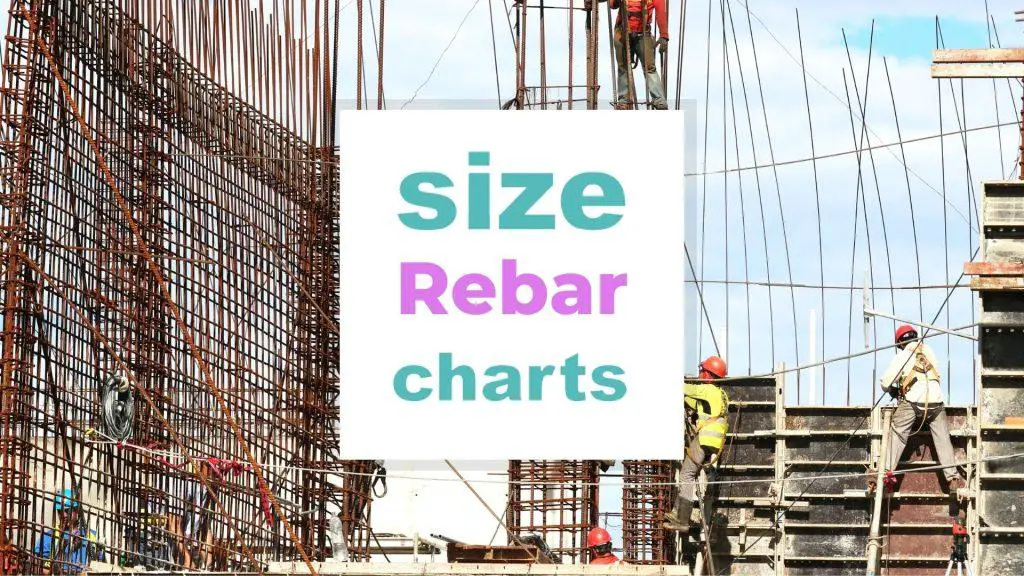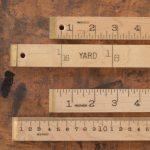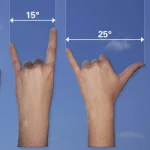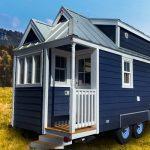Rebar Sizes Chart and Different Types
Rebar, which is short for reinforcing or reinforced steel bars, refers to a steel rod used to provide additional support to concrete during construction. Concrete is strong, but it’s susceptible to breakage when under stress. Adding rebar into the concrete can make a structure stronger and ensure you catch any major design issues early enough (skip straight to the Rebar Sizes Chart).

Different rebar sizing standards exist for different countries, and you can find a suitable chart in this comprehensive guide. The American Welding Society is responsible for providing standards for construction in the US. This can help identify potential quality issues as you choose a rebar size. Luckily, we’ve summarised everything you should know about rebar sizes in this post.
Now, you can find out which size of steel bars you need for your project in our rebar sizes charts.
Let’s get started!
Jump right into the Frequently Asked Questions
Related: Drill Bit Size Chart and Different Types, Nail Gun Size Chart and Types of Nails for all kinds of jobs, Printable Ruler In Cm: Make it Yourself
Table of content of Rebar Sizes Chart
- Rebar Sizes Chart
- Rebar Steel Types and Symbols
- Rebar Steel Grades Chart
- How to Choose the Right Rebar Size
- Types of Rebars – The Best Rebar for You
- Frequently Asked Questions
Rebar Sizes Chart
US/Imperial Steel Rebar Sizes Chart
| Imperial Bar Sizes | “Soft” Metric Size | Weight per unit length (lb/ft) | Mass per unit length (kg/m) | Nominal Bar Diameter (in) | Nominal Bar Diameter (mm) | Nominal Area(in2) | Nominal Area (mm2) |
| #3 | #10 | 0.376 | 0.561 | 0.375 | 9.525 | 0.11 | 71 |
| #4 | #13 | 0.668 | 0.996 | 0.500 | 12.7 | 0.2 | 129 |
| #5 | #16 | 1.043 | 1.556 | 0.625 | 15.875 | 0.31 | 200 |
| #6 | #19 | 1.502 | 2.24 | 0.750 | 19.05 | 0.44 | 284 |
| #7 | #22 | 2.044 | 3.049 | 0.875 | 22.225 | 0.6 | 387 |
| #8 | #25 | 2.67 | 3.982 | 1.000 | 25.4 | 0.79 | 509 |
| #9 | #29 | 3.4 | 5.071 | 1.128 | 28.65 | 1 | 645 |
| #10 | #32 | 4.303 | 6.418 | 1.27 | 32.26 | 1.27 | 819 |
| #11 | #36 | 5.313 | 7.924 | 1.41 | 35.81 | 1.56 | 1006 |
| #14 | #43 | 7.65 | 11.41 | 1.693 | 43 | 2.25 | 1452 |
| #18 | #57 | 13.6 | 20.284 | 2.257 | 57.33 | 4 | 2581 |
Canadian Rebar Sizes Chart
| Metric Bar Size | Mass per unit length (kg/m) | Nominal Diameter (mm) | Cross-Sectional Area (mm2) |
| 10M | 0.785 | 11.3 | 100 |
| 15M | 1.570 | 16.0 | 200 |
| 20M | 2.355 | 19.5 | 300 |
| 25M | 3.925 | 25.2 | 500 |
| 30M | 5.495 | 29.9 | 700 |
| 35M | 7.850 | 35.7 | 1000 |
| 45M | 11.775 | 43.7 | 1500 |
| 55M | 19.625 | 56.4 | 2500 |
European Rebar Sizes Chart
| Metric Bar Size | Mass per unit length (kg/m) | Nominal Diameter (mm) | Cross-Sectional Area (mm2) |
| 6,0 | 0.222 | 6 | 28.3 |
| 8,0 | 0.395 | 8 | 50.3 |
| 10,0 | 0.617 | 10 | 78.5 |
| 12,0 | 0.888 | 12 | 113 |
| 14,0 | 1.21 | 14 | 154 |
| 16,0 | 1.579 | 16 | 201 |
| 20,0 | 2.467 | 20 | 314 |
| 25,0 | 3.855 | 25 | 491 |
| 28,0 | 4.83 | 28 | 616 |
| 32,0 | 6.316 | 32 | 804 |
| 40,0 | 9.868 | 40 | 1257 |
| 50,0 | 15.413 | 50 | 1963 |
Australian Rebar Sizes Chart
| Nominal Diameter (mm) | Cross-sectional area (mm sq) | Mass per meter length, kg/m |
| 12 | 113 | 0.888 |
| 16 | 201 | 1.58 |
| 20 | 314 | 2.47 |
| 24 | 452 | 3.55 |
| 28 | 616 | 4.83 |
| 32 | 804 | 6.31 |
| 36 | 1020 | 7.99 |
New Zealand Rebar Sizes Chart
| Nominal Diameter (mm) | Cross-sectional area (mm sq) | Mass per meter length, kg/m |
| 6 | 28.3 | 0.222 |
| 10 | 78.5 | 0.617 |
| 12 | 113 | 0.888 |
| 16 | 201 | 1.58 |
| 20 | 314 | 2.47 |
| 25 | 491 | 3.85 |
| 32 | 804 | 6.31 |
| 40 | 1260 | 9.86 |
Jumbo Rebar Sizes Chart
| Metric bar size (soft) | Linear Mass Density | Nominal diameter (outside of threaded zone) | Nominal area (outside of threaded zone) | ||||
| Imperial bar size | lb⁄ft | (kg/m) | (in) | (mm) | (in²) | (mm²) | |
| #14J | – | 9.48 | 14.14 | 1.88 | 47.8 | 2.78 | 1794 |
| #18J | – | 14.60 | 21.78 | 2.34 | 59.4 | 4.29 | 2768 |
Threaded Rebar Sizes Chart
| Imperial bar size | Metric bar size (soft) | Linear Mass Density | Maximum diameter | Nominal area | |||
| lb⁄ft | (kg/m) | (in) | (mm) | (in²) | (mm²) | ||
| #20 | No.63 | 16.70 | 24.85 | 2.72 | 69 | 4.91 | 3168 |
| #24 | No.75 | 24.09 | 35.85 | 3.18 | 81 | 7.06 | 4555 |
| #28 | No.90 | 32.79 | 48.80 | 3.68 | 94 | 9.62 | 6207 |
| 1″ | No.26 | 3.01 | 4.48 | 1.25 | 32 | 0.85 | 548 |
| 1 1⁄4“ | No.32 | 4.39 | 6.53 | 1.45 | 37 | 1.25 | 806 |
| 1 3⁄8“ | No.36 | 5.56 | 8.27 | 1.63 | 41 | 1.58 | 1019 |
| 1 3⁄4“ | No.46 | 9.23 | 13.73 | 2.01 | 51 | 2.58 | 1665 |
| 2 1⁄2“ | No.65 | 18.20 | 27.08 | 2.80 | 71 | 5.16 | 3329 |
| 3″ | No.75 | 24.09 | 35.85 | 3.15 | 80 | 6.85 | 4419 |
Rebar Steel Types and Symbols
Related: Solar Panel Size Guide for residence and industry, Storage Unit Size Chart – Guide To Comparing Spaces
| Symbol | Steel Type |
| S | Carbon Steel |
| A | Axle Steel |
| W | Low-Alloy Steel |
| SS | Stainless Steel |
| CS | Low Carbon Chromium |
Rebar Steel Grades Chart
Related: Wrench Size Chart and Different Types
| Grade Mark | Maximum Yield Strength | PSI |
| 40 | 40 KSI | 40,000 PSI |
| 60 | 60 KSI | 60,000 PSI |
| 75 | 75 KSI | 75,000 PSI |
| 80 | 80 KSI | 80,000 PSI |
| 100 | 100 KSI | 100,000 PSI |
How to Choose the Right Rebar Size
Related: Staple gun Size Chart by model and staple gauge, Screw Size Chart And Thread Count Guide
When using the US/imperial rebar sizes, you should know that the chart displays the diameter in units of an eighth of an inch, equivalent to 3.2 mm. However, this mostly applies to bars #2 – #8, with the former translating to a quarter-inch and the latter representing a whole inch.
Bars smaller than size #3 are considered more like wires than bars because they are quite thin. The thicker the diameter, the higher the strength of the rebar. This is crucial because it determines the appropriate applications for different rebar sizes.
You should also check out the difference between tensile strength and minimum yield strength when choosing a rebar grade and size for your project.
Now, let’s overview the different places you can apply various rebar sizes.
#3 rebar
These carbon-steel rebars are mostly used for:
- Road construction,
- Driveway construction,
- Swimming pool frames,
- Patio construction
#4 rebar
Also made from carbon steel composite materials, these rebars are designed for:
- Residential construction
- Light commercial construction
- Paving highways and roads
- Strengthening concrete slabs, walls, and columns
#5 rebar
These rebars are made using super-strong carbon steel composite and are suitable for the following applications:
- Highway road construction
- Bridge construction
- Ground-level slabs,
- Patio deck construction,
- Residential construction
#6 rebar
These are mostly used for concrete reinforcement in:
- Foundation construction,
- Highway construction,
- Caissons,
- Deck-grade beams
#7 rebar
You can use these rebars for reinforcing:
- Roof construction,
- Multiple-story parking structures,
- Drainage structures
#8 rebar
This rebar size comprises high-quality carbon steel composite and is ideal for heavy-duty construction applications such as:
- Footings,
- Columns,
- High-rise concrete slabs,
- Sea walls,
- Bridge abutments,
#9 rebar
These are great for larger projects, and you can use them for:
- Retaining walls,
- Reinforcing abutments,
- High-rise buildings,
#10 rebar
This rebar size offers a high tensile strength which is why it’s suitable for a variety of construction projects. You can use them in beams and columns.
#11 rebar
Great for heavy-duty applications and load-bearing structures, this rebar size is meant for:
- Bridges
- Docks
- Tall buildings
#14 rebar
These thick rebars are good for:
- Tall buildings
- Parking structures
- Bridges
- Docks
- Industrial facilities
#18 rebar
This is the strongest option among standard rebars and comes in an epoxy-coated or black coating. Epoxy-coated bars are the optimal choice for marine-based environments because they are resistant to corrosion. Black rebars are the cheaper option if you aren’t exposing the bars to moisture.
Types of Rebars – The Best Rebar for You
Related: Size Chart for Bolts and Different Types, Lawn Mower Battery size guide (with easy to use size charts), Air Compressor Size Chart And Selection Guide
1. Carbon steel rebars
This is the most common type of rebar used in construction projects. It’s also known as a “black rebar” because of its color. Thanks to its durability and affordability, it’s a popular choice in both residential and commercial applications.
Unfortunately, carbon steel rebars aren’t resistant to corrosion caused by moisture. As such, you should use them in scenarios with lower chances of contact with water for the best results.
2. Stainless Steel Rebar
These are more expensive than their carbon steel counterparts but are a great alternative. Stainless steel is strong, which is why these bars are suitable for reinforcing weight-supporting structures like bridges and roads. These rebars are corrosion-resistant, giving them an advantage over carbon steel rebars.
3. Glass Fiber Rebar
Fiberglass rebar doesn’t contain any metallic compounds making it great for areas with high humidity or moist environments. This rebar will eliminate the risk of water damage and provide higher tensile strength. It’s also non-conductive and is much lighter than metallic rebars making it easier to transport.
4. Epoxy-Coated Rebar
This is the ultimate solution to any water-related issues since it features a thick layer of epoxy, greatly reducing corrosion. Unfortunately, the epoxy coating is easily susceptible to scratches during shipping, reducing its effectiveness against corrosion.
5. Galvanized Rebar
This rebar is pricey, but it comes with a water-resistant coating reducing the chances of corrosion. It closely compares with the epoxy-coated rebars.
6. Welded Wire Fabric Rebar
These rebars are made from welded low-carbon steel wires and come in a grid pattern. They are great for supporting concrete slabs.
7. Expanded Metal Rebar
This one is also a metal mesh but comes in a diamond pattern. This is the rebar to use when adding plaster to concrete for additional support. It’s also used for sidewalks and other walking surfaces.
Learn more about the different rebars sizes (video)
Frequently Asked Questions on Rebar Sizes Chart
Which is bigger, #4 or #5 rebar?
A #5 rebar is bigger in diameter than a #4 rebar.
What size is a number 3 rebar?
The diameter of a #3 rebar is 0.375 inches or 9.525 mm.
What diameter is a number 4 rebar?
A #4 rebar has a diameter of 0.5 inches or 12.7 mm.
What size rebar is number 5?
A number 5 rebar measures 0.625 inches or 15.875 mm.
Conclusion
While concrete is a reliable raw material in construction, it won’t hold up well on its own. Fortunately, including rebars in your concrete structure will make it stronger, more durable, and less risky for people to use.
Imperial rebar sizes are the standard in the US, but different countries have various rebar sizing systems. Now that you know what rebar size is ideal for your project, you can ensure everything goes as smoothly as possible.
If you have questions about rebar sizes, please comment below!
Picture in this post is by Ricardo Gomez Angel on Unsplash
Related to Rebar Sizes Chart
- Barbie Doll Size : What are different sizes of Barbie ?
- Blanket sizes chart : blanket sizes and dimensions in inches & cm
- Tablecloth size chart – What are standard tablecloth sizes ?
- How Many Meters Are In A Yard?
- How Many Centimeters are 8 Inches?
- Knife Sizes and Different Types
- 4 Inches is How Many Centimeters?
- Light Bulb Base Sizes : What size light bulb base do I need?
- Tesalate Towel Size Guide
- Light bulb Size : What are the different and standard bulb sizes?
- Duvet Sizes: What is a Standard-Size Duvet?
- Single Car Garage Size and Dimensions
- How High Is A Story?
- How Much Does 1 Cup Of Rice Weigh?
- Cast Iron Skillet Sizes: What Size Do I Need?
- Dollar Bills Size Chart
- Pizza Sizes: Which One to Order?
- How To Measure A Foot Without A Ruler
- Wine Glass Size Chart
- Tiny Houses Size Charts
- How Many Inches Are In 20 Centimeters?
- How To Measure 1 Meter Without A Ruler?






















